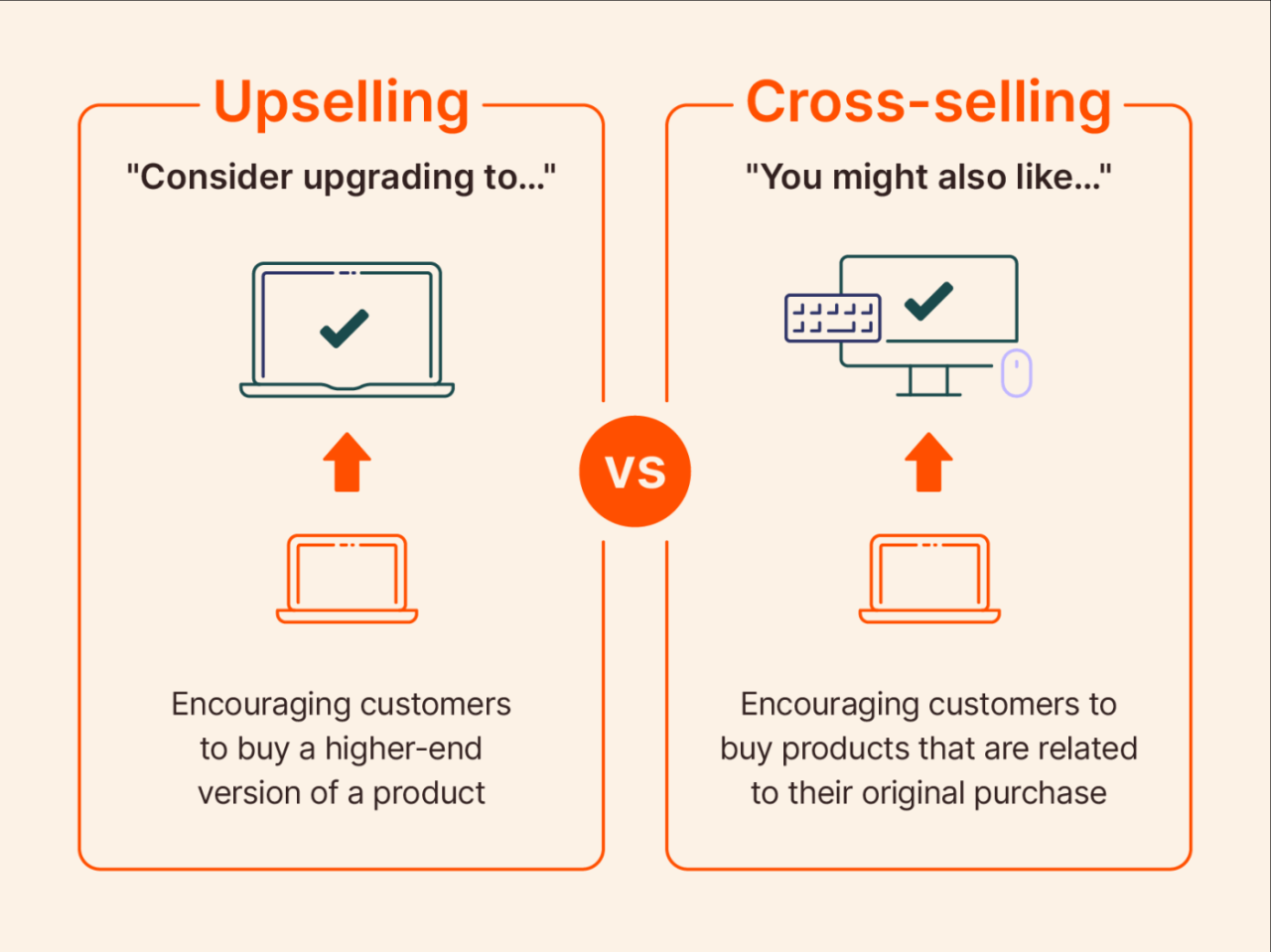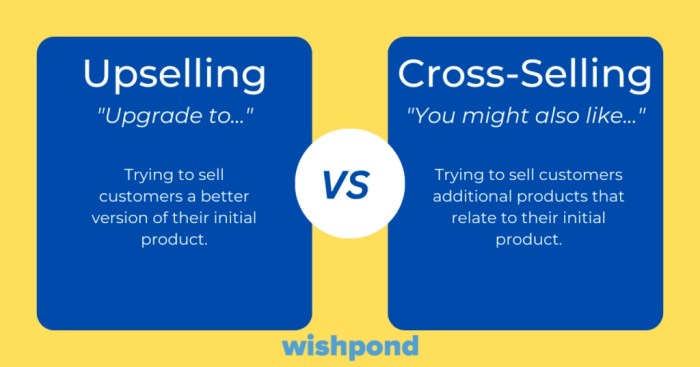Kicking off with Upselling and Cross-selling, dive into the world of increasing revenue and customer satisfaction with these dynamic techniques. Get ready to explore successful strategies that drive sales in various industries.
Upselling and Cross-selling Overview

Upselling and cross-selling are two essential strategies used by businesses to increase revenue and maximize profits. While both techniques aim to increase the value of each sale, they differ in their approach.
Upselling involves persuading a customer to purchase a higher-end product or upgrade to a more expensive version of what they are already buying. On the other hand, cross-selling involves offering complementary or related products to the customer in addition to their initial purchase.
Importance of Upselling and Cross-selling
Implementing upselling and cross-selling strategies can significantly impact a company’s bottom line by increasing the average order value and customer lifetime value. By recommending additional products or upgrades, businesses can enhance the overall shopping experience for customers while driving additional revenue.
- Amazon is a prime example of successful cross-selling, as they recommend related products to customers based on their browsing and purchase history.
- McDonald’s utilizes upselling by suggesting customers to “supersize” their meals for a small additional cost, increasing the overall transaction value.
- Software companies often offer premium features or add-ons to customers during the checkout process, encouraging them to upgrade to a higher-priced package.
Benefits of Upselling

When it comes to upselling, businesses can reap a variety of benefits that can significantly impact their bottom line. By offering customers additional products or services that complement their initial purchase, businesses can increase their average order value and overall revenue.
Increased Revenue
- Upselling allows businesses to capitalize on the opportunity to sell more to each customer, thereby increasing their total sales revenue.
- By suggesting higher-priced items or upgrades, businesses can boost their profit margins and overall financial performance.
Enhanced Customer Satisfaction
- By recommending products that enhance the customer’s initial purchase, businesses can improve the overall shopping experience and satisfaction levels.
- Customers may feel more valued and understood when offered relevant upsell options, leading to increased loyalty and repeat business.
Real-Life Scenarios
- A fast-food chain successfully upsells customers from a regular combo meal to a larger size, resulting in a significant increase in revenue per transaction.
- An online retailer suggests related accessories to customers purchasing electronics, leading to higher average order values and improved customer satisfaction.
Strategies for Effective Upselling
When it comes to upselling, there are various strategies that can help you increase sales without being too pushy. By understanding different approaches and personalizing techniques based on customer behavior, you can effectively implement upselling strategies.
Different Approaches to Upselling
- Bundle Deals: Offer customers a bundle of products or services at a discounted price when they purchase a certain item.
- Upgrade Options: Suggest higher-tier products or services that offer additional features or benefits.
- Complementary Products: Recommend products that complement the customer’s purchase, enhancing their overall experience.
Personalizing Upselling Techniques
- Use Customer Data: Analyze past purchases and preferences to tailor recommendations to each individual customer.
- Listen to Customer Needs: Pay attention to customer feedback and behavior to understand their specific needs and offer relevant upsell options.
- Provide Relevant Recommendations: Offer upsells that align with the customer’s interests and purchasing history.
Implementing Upselling Strategies Successfully
- Focus on Value: Highlight the benefits and value-add of the upsell to show customers why it’s worth it.
- Timing is Key: Present upsell options at the right moment during the customer’s buying journey, such as after they’ve made a decision to purchase.
- Offer Incentives: Provide discounts, promotions, or exclusive deals to sweeten the upsell offer and encourage customers to take advantage.
Benefits of Cross-selling
Cross-selling is a sales technique where a company suggests additional products or services to a customer who is already making a purchase. This strategy not only increases the company’s revenue but also offers several benefits for businesses.
Increased Revenue Streams, Upselling and Cross-selling
Cross-selling allows businesses to generate additional revenue by selling complementary products or services to existing customers. By recommending related items, companies can maximize the value of each transaction and boost their overall sales.
- Companies can capitalize on the customer’s interest and offer products that align with their needs and preferences.
- It helps in increasing the average order value, leading to higher profits.
Building Customer Loyalty
Cross-selling can play a crucial role in building customer loyalty and enhancing the overall shopping experience. By providing personalized recommendations and offering relevant add-ons, businesses can strengthen their relationship with customers and increase brand loyalty.
- Customers appreciate personalized suggestions that cater to their specific needs, enhancing their shopping experience.
- By offering complementary products, companies can demonstrate their understanding of the customer’s preferences and priorities.
Examples of Successful Cross-selling
Numerous companies have excelled in cross-selling their products or services, showcasing the effectiveness of this strategy in driving sales and enhancing customer satisfaction.
- Amazon is known for its successful cross-selling tactics, suggesting related products based on the customer’s browsing and purchase history.
- McDonald’s offers combo meals with add-ons like fries and drinks, encouraging customers to upgrade their orders and increase the overall purchase value.
Strategies for Effective Cross-selling
To successfully cross-sell, it’s crucial to employ key tactics that can maximize sales and customer satisfaction. One of the most effective strategies is utilizing product bundling to offer customers a package deal that includes complementary items. This not only encourages customers to purchase more but also enhances the overall value they receive.
Utilizing Product Bundling
Product bundling involves grouping related items together and offering them at a discounted price when purchased as a bundle. This strategy is effective in cross-selling as it entices customers to buy additional products that complement their original purchase. By highlighting the benefits of purchasing the bundle, such as cost savings or convenience, you can increase the likelihood of cross-selling success.
- Bundle products that naturally go together or enhance each other’s functionality.
- Offer a discount or special promotion for purchasing the bundle.
- Create attractive packaging and marketing materials to showcase the value of the bundle.
Product bundling can increase the average order value and customer satisfaction by providing a convenient and cost-effective way for customers to purchase related items together.
Identifying Complementary Products
To identify complementary products for cross-selling opportunities, it’s essential to understand your customers’ needs and preferences. Analyzing past purchase data and conducting market research can help you pinpoint products that are frequently purchased together or are logically related. By recommending these complementary products to customers during the buying process, you can increase the chances of a successful cross-sell.
- Use customer purchase history to identify patterns and correlations between products.
- Offer personalized recommendations based on customer preferences and behavior.
- Provide clear and relevant product suggestions that add value to the customer’s original purchase.
By proactively suggesting complementary products that meet customers’ needs, you can enhance their shopping experience and drive additional sales through cross-selling.
